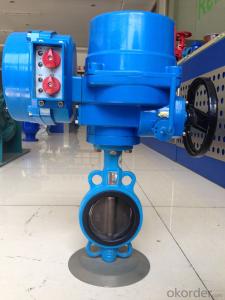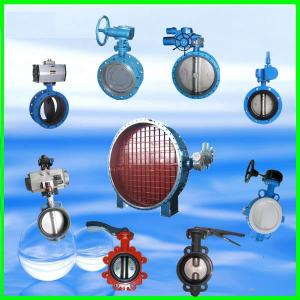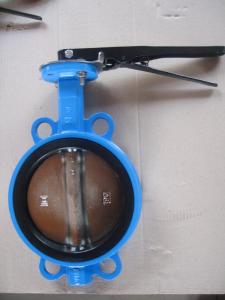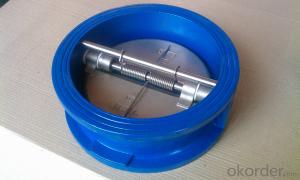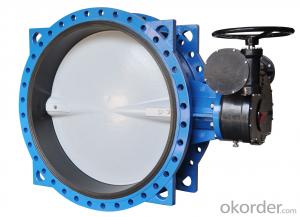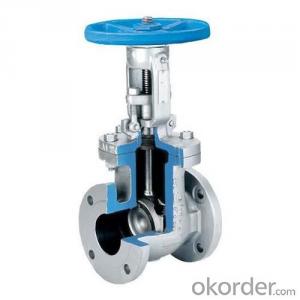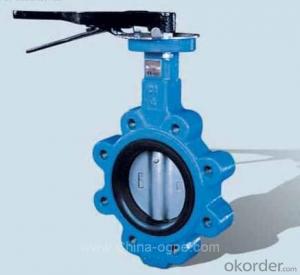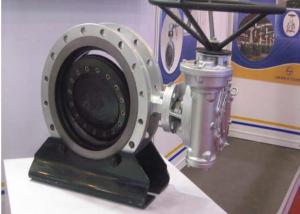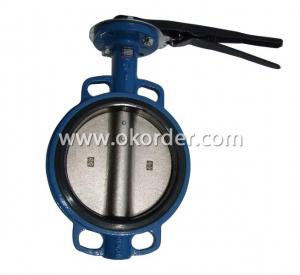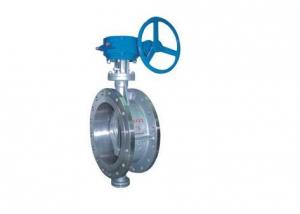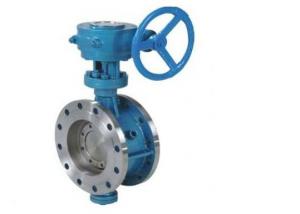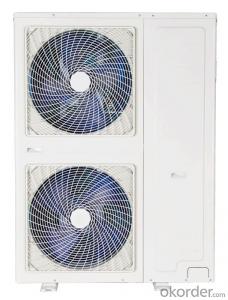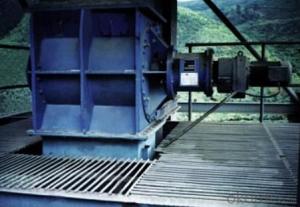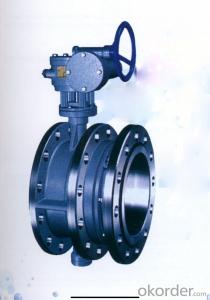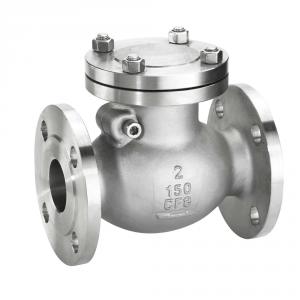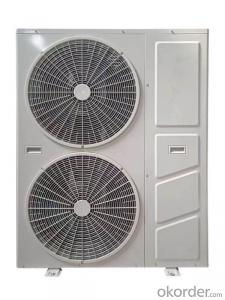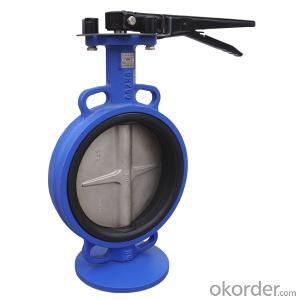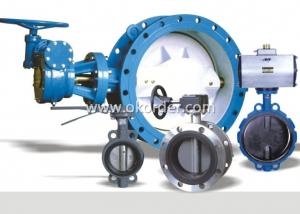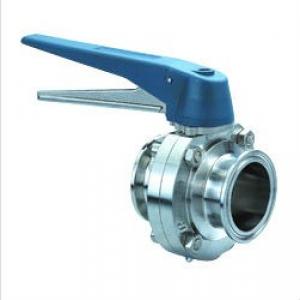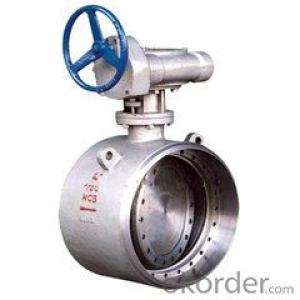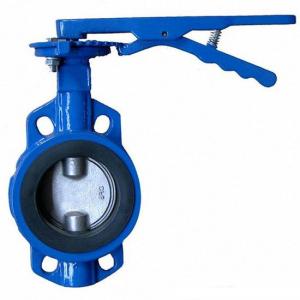Electric Wafer Butterfly Valve DN25-DN300
- Loading Port:
- Tianjin
- Payment Terms:
- TT OR LC
- Min Order Qty:
- 1 unit
- Supply Capability:
- 10000 unit/month
OKorder Service Pledge
OKorder Financial Service
You Might Also Like
1.Technical Date:
Size: DN40-DN1200
Nominal Pressure: PN10/PN16
Operation Temperature: -10°C~150°C
Suitable Medium: Water,Sewage,Seawater,Gas,Food,Oils,etc.
2. Standard
Design Standard: GB/T 12238-2008
Structural Length: GB/T 12221-2005
Top Flange dimensions: ISO5211
Face to face dimensions: GB9112,DIN2501,BS4504,ISO2084,ANSI125
Type of connection: Wafer Type
3. Feature:
This valve is mainly composed of body, butterfly plate, valve shaft, seat and transmission devices. Simple and compact structure, small portable, convenient for transport, install and dismantle. 90 degrees of opening and closing, switch quickly, operating is small, light energy; Sealing performance is good, service life is long, can achieve zero leakages. Flow curve tending to straight line, excellent regulation performance.
Electric actuators can be divided into basic, overall switch model, external regulation as a whole. Electric device can provide or customer designated brand.
4. Sealability:
The valve for rubber seal, closing butterfly plate and seat sealing performance is good, two-way sealed good performance and the torque is small. the friction is very small between butterfly plate and the seat seal. The valve shaft drive the butterfly plate, butterfly plate do 90 degrees rotation. Butterfly plate flexible for opening and closing, no card acerbity, beating phenomenon, small torque.
- Q:Butterfly valve structure and working principle
- How it works: the disc is driven by the stem, and if it turns 90 degrees, it can be opened and closed once. By changing the deflection angle of the plate, the flow of the medium can be controlled. There are two kinds of butterfly valves commonly used: clip type butterfly valve and flanged butterfly valve.
- Q:I am confused as to the answer of this question. Please help.Indicate the status of the mitral, tricuspid and semilunar valves (whether they are open or closd) during the various phases of the cardiac cycle. Discuss the pressure in each of the relevant chambers or blood vessels during the phases with reference to the opening or closing of the valves.
- A heartbeat is a two-part pumping action that takes about a second. As blood collects in the upper chambers (the right and left atria), the heart's natural pacemaker (the SA node) sends out an electrical signal that causes the atria to contract. This contraction pushes blood through the tricuspid and mitral valves into the resting lower chambers (the right and left ventricles). This part of the two-part pumping phase (the longer of the two) is called diastole. The second part of the pumping phase begins when the ventricles are full of blood. The electrical signals from the SA node travel along a pathway of cells to the ventricles, causing them to contract. This is called systole. As the tricuspid and mitral valves shut tight to prevent a back flow of blood, the pulmonary and aortic valves are pushed open. While blood is pushed from the right ventricle into the lungs to pick up oxygen, oxygen-rich blood flows from the left ventricle to the heart and other parts of the body. After blood moves into the pulmonary artery and the aorta, the ventricles relax, and the pulmonary and aortic valves close. The lower pressure in the ventricles causes the tricuspid and mitral valves to open, and the cycle begins again. This series of contractions is repeated over and over again, increasing during times of exertion and decreasing while you are at rest. The heart normally beats about 60 to 80 times a minute when you are at rest, but this can vary. As you get older, your resting heart rate rises. Also, it is usually lower in people who are physically fit.
- Q:Check valve; flexible joint `; installation order of electric butterfly valve
- Connect the Songjiang rubber joint from the pump outlet. Check the 1 valve
- Q:valve adjustment 2001 chev prism 1.8L
- valve adjustment . you need to know the fire order. the gage between the stem. rotators the cranshaft. it could be cold start. cylinder need to be bottomed center.
- Q:Electric butterfly valve (not take the lead) what do you mean?
- Electric butterfly valve, as its name implies, consists of an electric actuator and butterfly valve, and the customer does not take the lead, that is, without the electric actuator, only the butterfly valve can be provided.
- Q:What does butterfly valve do?
- Butterfly valve (English: butterfly valve) refers to the closure of parts (valve or butterfly plate) for the disk, around the valve shaft to achieve rotation and closure of a valve, the main cut off on the pipe and throttling. Butterfly valve headstock is a disc shaped disc, in the valve body around its own axis of rotation, so as to achieve the purpose of opening or closing or regulation. Butterfly valve is fully open to fully closed is usually less than 90 degrees, butterfly and butterfly stroke itself has no self-locking capability, in order to position the disc to install the valve stem on the worm gear. Using worm gear reducer, not only can the butterfly plate have self-locking ability, so that the butterfly board stops at any position, but also can improve the operation performance of the valve. Industrial butterfly valve features, capable of high temperature, applicable pressure range is higher, the valve nominal diameter is large, the valve made of carbon steel, the valve plate sealing ring using metal rings instead of rubber rings. Large high temperature butterfly valve welded by steel plate, mainly used for high temperature smoke duct and gas pipe.
- Q:For whatever reason, Mazda has made it next to impossible to change the PCV valve on the 929. I'm going to have to pull off the plenum and the passenger's side valve cover to replace a $2.00 PCV valve. Before I get too involved, I need to know the torque specs for the valve cover. Also, any other tips on this process would be greatly appreciated. Can I reuse the old valve cover gasket if it's still in good shape? Should I use any kind of sealant in addition to the gasket when I put it all back together? Thanks in advance, by looking at this motor, I can tell I'll have my work cut out for me (for a friggin $2.00 PCV valve, it's usually SO simple!). Like I said, any and all help is greatly appreciated.
- Mazda 929 Specs
- Q:Transformer butterfly valve and pressure relief valve difference
- The butterfly valve is usually fitted with an oil immersed transformer between the tank and the radiator to control the flow of oil between the transformer tank and the heat sink. When large power transformers are delivered, the radiators are usually individually packed to reduce transport sizes. The butterfly valve is closed to prevent the outside air or water from entering the transformer tank. When the transformer is transported to the installation site, the radiator is installed on the butterfly valve one by one. When the radiator is installed, the butterfly valve can be opened so that the oil flow between the transformer, the oil tank and the radiator can be circulated, so as to play the role of heat dissipation.When the transformer is running, it is found that when the radiator has seepage, the butterfly valve can be closed to avoid further leakage of transformer oil, and a new radiator can be replaced.
- Q:My bike has now 6200 miles on the odometer. The manual says that a valve adjustment should be performed every 6000 miles. But the bike runs fine. Can I just have the valve checked or should I have them adjusted even though the bike is fine? What will happen if I just keep riding it?
- if the valves are not chattering (WOrse then normal) and you havent lost power or gas milage, then no...dont get it adjusted and no ... your not hurting the bike.
- Q:Whenever sports cars are referred, people talk in terms of 'valves'. ex: v8, v12 etc. What does this all mean? Also they sometimes say that a v8 makes a great noise. why? How does the number of valves effects the performance? Many thanks.
- the v is in reference to the motor its in a v formation v8 4 cyliders on each side v6 3 per side v12 6 pre side now the valves is how many are in each cylinder you usually have 3 or 4 valves per cylinder the more valves the more horsepower the more cylinders the bigger the engine
1. Manufacturer Overview |
|
|---|---|
| Location | |
| Year Established | |
| Annual Output Value | |
| Main Markets | |
| Company Certifications | |
2. Manufacturer Certificates |
|
|---|---|
| a) Certification Name | |
| Range | |
| Reference | |
| Validity Period | |
3. Manufacturer Capability |
|
|---|---|
| a)Trade Capacity | |
| Nearest Port | |
| Export Percentage | |
| No.of Employees in Trade Department | |
| Language Spoken: | |
| b)Factory Information | |
| Factory Size: | |
| No. of Production Lines | |
| Contract Manufacturing | |
| Product Price Range | |
Send your message to us
Electric Wafer Butterfly Valve DN25-DN300
- Loading Port:
- Tianjin
- Payment Terms:
- TT OR LC
- Min Order Qty:
- 1 unit
- Supply Capability:
- 10000 unit/month
OKorder Service Pledge
OKorder Financial Service
Similar products
New products
Hot products
